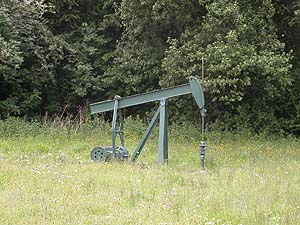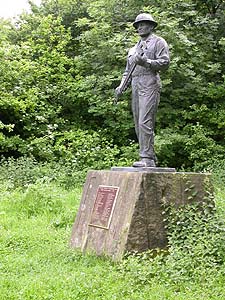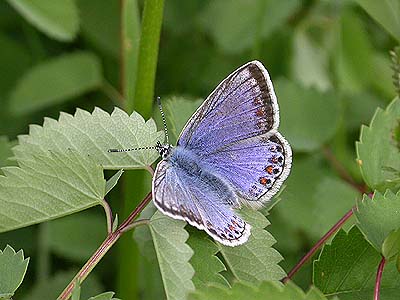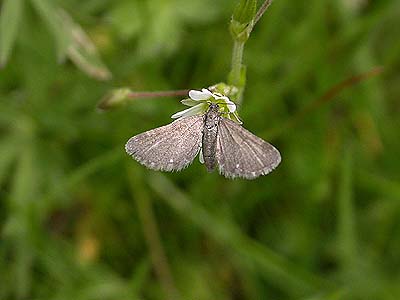

| Oil-drilling - a threat to local wildlife? |
| Some years ago, I
recieved an invitation by local villagers to attend a
meeting in Eakring's Cator Hall, where local people could
voice their objections and concerns about the proposed
application to Nottinghamshire County Council by Stag
Energy, to drill for oil at a site on the outskirts of
Eakring. At a private meeting the previous evening, I was able to listen to some deeply worried parties voicing their concerns - one aspect of which was the possible affect that this would have on the area's wildlife. Within the small number present, little was known about - exactly what wildlife is found here; how even the smallest invertebrate can be of county significance (as a rarity value) and how flora and fauna populations manage to survive as fragile and isolated colonies. |
 |
|
| .... | ||
| Proposed
plans and objections During the Second World War, some 2 000 000 barrels of oil was pumped out of the ground in Dukes Wood by BP. Today a commemorative statue to the oil-workers who came over from America, can be found near the small mining museum in place today. Still in situ today, are some of the many "nodding donkeys" that were used during the process. Whilst if the current drilling application is successful one nodding donkey will be used, during the interim period a 40m high drilling rig will be in place to do the drilling. With it comes the potential for various forms of pollution and this is part of the reason, why local people are concerned and against the project. Eakring has also been designated as a conservation village. |
||
| .... | ||
| Stag Energy have obtained
a licence from the DTI (covering a rectangular area
including Eakring and extending to the edge of
Kirklington) and lodged a planning application, initially
for one well sited on land located off Tenters Lane and
Flats Lane with access via Bilsthorpe Road. Residents believe that if successful, this can potentially lead to a number of other wells, with the aim of extracting an estimated figure of 2.5 billion barrels of oil over a 15 year period. Stag Energy deny this and dispute the figures quoted. Among the many concerns raised, is that this will have a devastating impact on the local bird, animal & plant life - through noise, light or gas pollution among others. A personal view of the meeting The meeting was attended by several representatives from Stag Energy, Nottinghamshire County Council, Eakring Parish Council and an estimated 100 local people - those either opposed to the drilling and those with neither for - nor against views. |
 |
|
| .... | ||
| The
impression I got, was that around 80% of people
attending, objected to the proposals on various grounds
and interests.Commonest were the effects of noise and
light pollution on neighbouring residences; the potential
value reduction on property and concerns over the
significant rise in heavy traffic. Stag Energy put
forward their views and answered claims and questions
from letters recieved in a manner quite expected from
such a company - that there would be minimal
disturbance of any kind and that there was a general
over-reaction and "they thought" unwarranted
anti-drilling feeling amongst the public. There were
unconvincing assurances that this was a one-off drilling
operation (but at the same time) never categorically
ruled out the threat of more operations of this kind in
the future. The potential threat to Eakring's wildlife The effect on wildlife was not mentioned at the meeting and I saw little point in raising the matter at the time as there were no people present, who could have provided suitable and qualified answers. What was quite clear among those present, was that the many showed little concern or care for wildlife. There's no doubting though, the threat that drilling could have on the area's wildlife. It is fair to say that if the drilling goes as Stag Energy forcasts (it's effects completely minimalised by careful monitoring) then there should be little or no problem. A greater threat will come from the potential other wells which could be sited around the area, where well-siting could be on or nearer much more sensitive areas. |
||
| .... | ||
 |
One of the benefits of
solely covering any single site or area of countryside -
with it showing a broader interest in that area's flora
and fauna, is that it creates the potential to provide
conservation bodies with much greater ammunition against
any potential industrial development. Protection of important SSSI sites and routine maintanence work of such by organisations like the Nottinghamshire Wildlife Trust help ensure that the relatively few sites left, remain for future generations. There is a tendancy for many people to assume that SSSI's and other important sites have recieved full coverage of the wildlife they hold. Unfortunately this is not always possible, due to the costs of such surveys and a lack of people able to do the work on a voluntary basis. Many site surveys are (or have been) solely based upon their botanical interest alone. Since I started covering the Eakring and Kersall area in 1998, I have come to know the area's wildlife more than most, being able to devote an enormous amount of time and effort in the process. But the rewards have been great, with discoveries of species here that had been previously unrecorded. |
|
| .... | ||
| As with most
agricultural areas, wildlife has suffered over the years.
Many species of birds and insects have been lost under
the plough or by the considerable over-use of pesticides
and herbicides. Fortunately, times and modern farming
methods have begun to change, but already (for much of
the wildlife) it has come far too late. Some species
still hang on here, either as isolated colonies of
butterflies and moths, or in the case of several species
of birds - to just one or two pairs, now entirely
restricted through habitat loss. Especially susceptible
to disturbance are Orchids and mammals and work has gone
into identifying those which occur. Three species of
Orchid are found here. All now being restricted to one or
two sites including the former oil-drilling site in
Eakring village. The area also holds notable numbers of
Brown Hare and a healthy Water Vole population. Species under threat The following list contains the most threatened species the area currently holds breeding populations of. It has largely been derived from my own records accumulated since 1998. Not all are rare on a county level and indeed, some are commonly met with at many Nottinghamshire sites. |
||
| .... | ||
| One Grade 2 listed moth
found recently is pictured below right. The discovery of
Marsh Pug at three sites in the area at the end of May
2003, means that Eakring is now only the second known
area for the species in the county. It was formerly known
only from the Misterton area of North Notts, but this
discovery shows just how little is actually known even on
sites designated as SSSI's or nature reserves. It also
shows the benefits in recording both macro and
microlepidoptera Microlepidoptera however are not included in the list below, as I currently have no information available regarding their status in Nottinghamshire. It's probably fair to say that some species recorded, are equally as threatened as their larger relatives and accordingly afforded a Graded status. Many have occurred as single records though and have yet to be traced to a viable colony/colonies. Much work remains to be done here on all aspects of wildlife and the list provided is just a small indication of the variety of species found in the Eakring area. |
 |
|
| Population status | Cause of status | |||
| Birds | ||||
| Lesser Whitethroat | Maximum of five pairs in 2003 | Modern farming methods/habitat restriction | ||
| Tree Sparrow | Of major concern - down to just two/three pairs | Modern farming methods/habitat restriction | ||
| Goldcrest | Only three pairs at two sites | Habitat restriction | ||
| Willow Tit | Three pairs in the area | Modern farming methods/habitat restriction | ||
| Turtle Dove | Of major concern in the area - only one pair in 2003 | Modern farming methods/habitat restriction | ||
| Skylark | Increasing, but still vulnerable | Modern farming methods | ||
| Grey Partridge | Three pairs in 2003, but population still under great threat | Modern farming methods | ||
| Lapwing | Variable (but very low numbers) | Modern farming methods | ||
| Bullfinch | Just four pairs in the area of study | Modern farming methods/habitat restriction | ||
| Grasshopper Warbler | Just one pair most years | Modern farming methods/habitat restriction | ||
| Mammals | ||||
| Water Vole | Healthy numbers at one site. Nationally protected and in decline | Habitat restriction | ||
| Brown Hare | Important numbers at a county level | Modern farming methods | ||
| Butterflies | ||||
| Common Blue | Small, scattered, low density colonies at several sites | Modern farming methods/habitat restriction | ||
| White-letter Hairstreak | One colony - the rarest annually breeding species | Habitat restriction - severe | ||
| Brown Argus | First appeared at two sites in 2000. No records since | Habitat restriction - severe | ||
| Small Heath | Tiny population with no single concentrated colony | Modern farming methods/habitat restriction | ||
| Moths | ||||
| White-spotted Pug | A Grade 3 listed species | Habitat restriction | ||
| Latticed Heath | Two adults recorded from one site in 1999 | Habitat restriction | ||
| Brown Silver Line | One colony in the area | Habitat restriction - severe | ||
| Marsh Pug | Colonies found at three sites. A Grade 3 listed species | Habitat restriction - severe | ||
| Gold Swift | A Grade 2 listed species | Habitat restriction | ||
| Lesser Cream Wave | A Grade 3 listed species | Habitat restriction - severe | ||
| Cream Wave | A Grade 3 listed species | Habitat restriction - severe | ||
| Lunar Marbled Brown | A Grade 3 listed species | Habitat restriction | ||
| Rufous Minor | A Grade 3 listed species | |||
| Orchids | ||||
| Bee Orchid | Present at one small Eakring village site | Habitat restriction - severe | ||
| Marsh Orchid | Found at just two small sites | Habitat restriction - severe | ||
| Common Spotted Orchid | Present at one site | Habitat restriction - severe |
| Other
on-going threats to wildlife As large a potential threat as the proposed drilling is, another (equally as damaging) is the current building work within Eakring village. Over the last two years, Eakring has seen three farm building/barn conversions and several new houses built within former gardens. Established gardens are as vital to many species as areas of rich grassland - providing a surprisingly large array of species with food and cover for breeding and as stop over points for migrating birds. Work will soon start on the former Methodist Chapel, recently sold at auction. How sympathetic building/conversion work will be in this case, remains to be seen. Eakring is typical of many Nottinghamshire villages, now at much greater risk from development than ever before. |
||
| Related links | ||
| ...... | ||
| Hedgerow Loss | How the area has been affected by decades of hedgerow removal | |
| SINC/SSSI Sites | SINC and SSSI sites within the area | |
| Mammals | The status of the area's mammals | |
| Water Voles | A guide on where to see Water Voles in the area. New photos added during Feb 2003. | |
| Orchids | Read about the Orchids found here, but restricted to two private sites | |